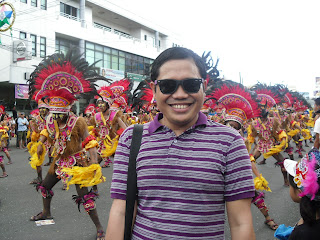an essay by Roger B Rueda
Early December, in the small hours, the whole city resounds with the thuds of beats on drums, in the distance. They are rhythmical, very marvellous, wafting out everywhere. Shoppers at the city centre tarry on the street corner looking at the drummers. Everyone thrills at the coming of their favourite festival.
All the details of the Dinagyang are fresh in my memory. The city centre, which has narrow streets, is closed for the festival. Drivers stop their jeepneys and commuters have to walk a hundred steps from Jalandoni Street in Jaro District to the city centre. The Forbes Bridge becomes busy with walkers. People swarm to the shops along the streets, buying up everything in sight – everywhere is packed with men, women, and children. Both locals and tourists are bursting with energy and vivacity.
Every mall is teeming with shoppers, music blaring out. Their lobbies are chock-a-block with spectators and merrymakers. Everyone joins the festival with spirit. Dinagyang costumes, props, and photographs are on exhibition at almost all local shops. The city is full of atmosphere and well worth visiting.
Every tribe is dressed in their finest attire. Last year, I loved the tribe whose costume motif was a jungle. Each member then was dressed in creeper-like cloths. The tribe whose headdress was made of rooster tail feathers and mats made of buri leaves was also charming. Their female members had cute curly wigs. When they gathered round, they looked a lot like real Atis.
The backdrops and props of every tribe provide a matchless experience, their presence a cultural means for the Ilonggos. The ones I can’t forget are the humongous heads of an Ati man and a prodigious Santo Nino. Too, the trees that were magically transported through the streets. Way off, they looked great and eye-catching. Actually, I happened to pose with them for some photographs, banderitas strung up over the street.
The dances of every ethnic group put together well enliven the mundane realities of life. They are an engrossing part of the festival, I believe. With incredible swiftness, the tribes whirl around the streets of the city centre and La Paz District. One at a time, a tribe prances as they move to another performing area. Some are rushed off their feet pulling their backdrops as some are enjoying posing with the crowds. Some members are thirsty and almost bushed, so they might ask for some bottles of water. Just be kind and generous – it’s supporting the Dinagyang in your own little way.
This year, the Ati Contest, the best bit of the Dinagyang, is on 27 January. Spectators have to be at the city centre as early as 7 AM. Everyone at the Dinagyang are packed in like sardines - blending into the crowds is a scramble.
By the way, 'dinagyang' means 'to enjoy ourselves as one.' It means, too, as 'a sort of gaiety.' It can also mean 'to be full of glee.' More than that, however, 'dinagyang' means 'celebrating the history and culture of the Ilonggo as a people' - it is a celebration that bewitches everyone at the streets, as Ilonggos share their culture, belief, and sense of worth with everyone around.
Largely, the festival rekindles olden times and celebrations, fostering solidarity amongst the people as they look back on their endeavours with pride. It is a festival of distinctiveness, of Ilonggohood.
Happy Dinagyang, everyone! Welcome to Iloilo City, la muy noble ciudad!
This year's celebration promises to be terrifically good fun, so for more information about the Dinagyang, visit http://dinagyangsailoilo.com/.










No comments:
Post a Comment